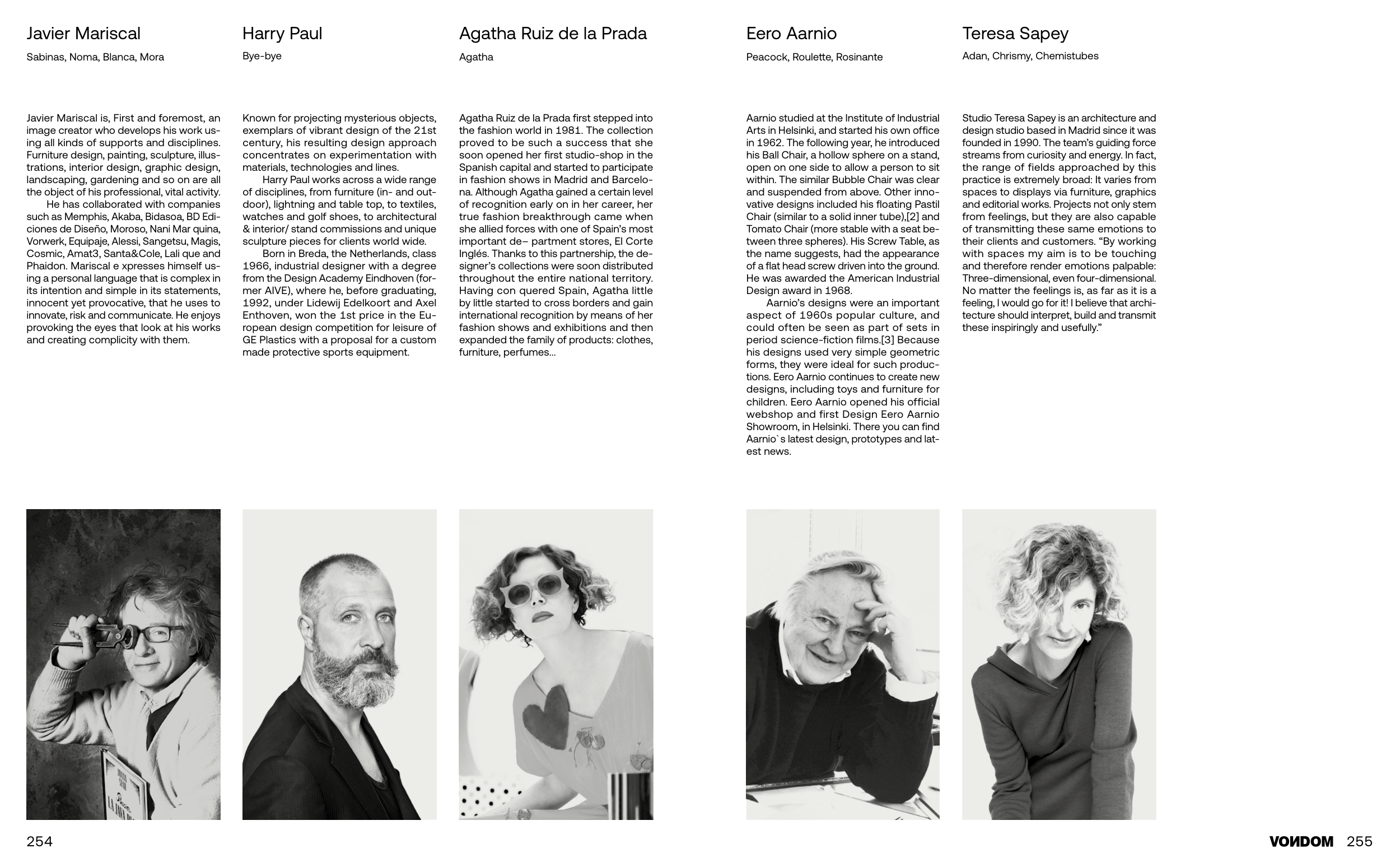255
254
Harry Paul
Bye-bye
Agatha Ruiz de la Prada
Agatha
Known for projecting mysterious objects,
exemplars of vibrant design of the 21st
century, his resulting design approach
concentrates on experimentation with
materials, technologies and lines.
Harry Paul works across a wide range
of disciplines, from furniture (in- and out-
door), lightning and table top, to textiles,
watches and golf shoes, to architectural
& interior/ stand commissions and unique
sculpture pieces for clients world wide.
Born in Breda, the Netherlands, class
1966, industrial designer with a degree
from the Design Academy Eindhoven (for-
mer AIVE), where he, before graduating,
1992, under Lidewij Edelkoort and Axel
Enthoven, won the 1st price in the Eu-
ropean design competition for leisure of
GE Plastics with a proposal for a custom
made protective sports equipment.
Agatha Ruiz de la Prada first stepped into
the fashion world in 1981. The collection
proved to be such a success that she
soon opened her first studio-shop in the
Spanish capital and started to participate
in fashion shows in Madrid and Barcelo-
na. Although Agatha gained a certain level
of recognition early on in her career, her
true fashion breakthrough came when
she allied forces with one of Spain’s most
important de– partment stores, El Corte
Inglés. Thanks to this partnership, the de-
signer’s collections were soon distributed
throughout the entire national territory.
Having con quered Spain, Agatha little
by little started to cross borders and gain
international recognition by means of her
fashion shows and exhibitions and then
expanded the family of products: clothes,
furniture, perfumes...
Javier Mariscal
Sabinas, Noma, Blanca, Mora
Javier Mariscal is, First and foremost, an
image creator who develops his work us-
ing all kinds of supports and disciplines.
Furniture design, painting, sculpture, illus-
trations, interior design, graphic design,
landscaping, gardening and so on are all
the object of his professional, vital activity.
He has collaborated with companies
such as Memphis, Akaba, Bidasoa, BD Edi-
ciones de Diseño, Moroso, Nani Mar quina,
Vorwerk, Equipaje, Alessi, Sangetsu, Magis,
Cosmic, Amat3, Santa&Cole, Lali que and
Phaidon. Mariscal e xpresses himself us-
ing a personal language that is complex in
its intention and simple in its statements,
innocent yet provocative, that he uses to
innovate, risk and communicate. He enjoys
provoking the eyes that look at his works
and creating complicity with them.
Eero Aarnio
Peacock, Roulette, Rosinante
Aarnio studied at the Institute of Industrial
Arts in Helsinki, and started his own office
in 1962. The following year, he introduced
his Ball Chair, a hollow sphere on a stand,
open on one side to allow a person to sit
within. The similar Bubble Chair was clear
and suspended from above. Other inno-
vative designs included his floating Pastil
Chair (similar to a solid inner tube),[2] and
Tomato Chair (more stable with a seat be-
tween three spheres). His Screw Table, as
the name suggests, had the appearance
of a flat head screw driven into the ground.
He was awarded the American Industrial
Design award in 1968.
Aarnio’s designs were an important
aspect of 1960s popular culture, and
could often be seen as part of sets in
period science-fiction films.[3] Because
his designs used very simple geometric
forms, they were ideal for such produc-
tions. Eero Aarnio continues to create new
designs, including toys and furniture for
children. Eero Aarnio opened his official
webshop and first Design Eero Aarnio
Showroom, in Helsinki. There you can find
Aarnio`s latest design, prototypes and lat-
est news.
Teresa Sapey
Adan, Chrismy, Chemistubes
Studio Teresa Sapey is an architecture and
design studio based in Madrid since it was
founded in 1990. The team’s guiding force
streams from curiosity and energy. In fact,
the range of fields approached by this
practice is extremely broad: It varies from
spaces to displays via furniture, graphics
and editorial works. Projects not only stem
from feelings, but they are also capable
of transmitting these same emotions to
their clients and customers. “By working
with spaces my aim is to be touching
and therefore render emotions palpable:
Three-dimensional, even four-dimensional.
No matter the feelings is, as far as it is a
feeling, I would go for it! I believe that archi-
tecture should interpret, build and transmit
these inspiringly and usefully.”


